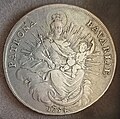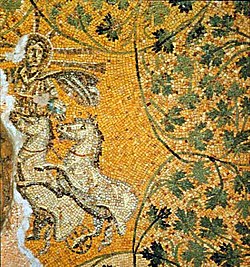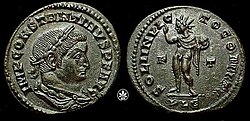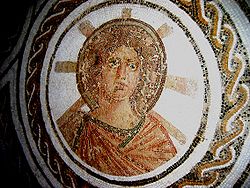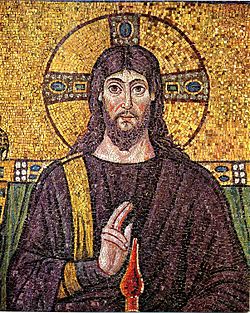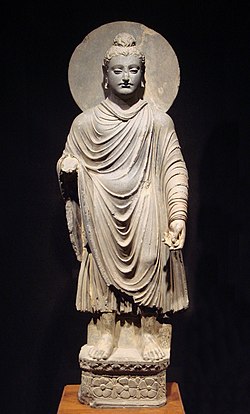Heiligenschein


Der Heiligenschein, der Nimbus oder die Gloriole (lateinisch nimbus ‚Wolke‘, speziell ‚Stirnbinde‘; ‚Heiligenschein‘; altgriechisch ἅλωςhálōs, deutsch ‚Tenne, Rundung, Hof um Sonne oder Mond, Strahlenkreis‘)[1][2] ist eine Leucht- oder Lichterscheinung um den Kopf oder den ganzen Körper einer Personendarstellung. Unterformen des Nimbus, die den kompletten Körper der Personendarstellung umfassen, sind die kreisförmige „Aureole“ und die mandelförmige Mandorla. Der Nimbus ist in der Kunst ein Symbol für Mächtige, Erleuchtete, Heilige oder Götter. Eine Leucht- oder Lichterscheinung, eine Sonnenkrone oder ein Strahlenkranz (lateinisch: Corona radiata) um den Kopf oder den Körper in Darstellungen besonderer Menschen ist in vielen Kulturen bekannt.
Darstellung
In der Kunst wird der Nimbus bei heiligen, herrschaftlichen oder göttlichen Figuren in vielfältiger Weise dargestellt. Umgibt er die ganze Gestalt in Kreisform, so heißt er „Aureole“, in Mandelform „Mandorla“. Hinter dem Haupt ist der Glorienschein ein „Nimbus“. Außerdem gab es Maler, die den Nimbus dynamisch mit den Bewegungen des Kopfes in Beziehung setzten. Er wurde leuchtend und strahlend gemalt, als ob er ein Licht aussende (in der Regel weiß, gelb, silbern oder golden). Noch lebende Persönlichkeiten wurden zeitweise mit eckigem Nimbus dargestellt.
- Christus als Sol invictus mit siebenstrahliger Sonnenkrone des Helios im Sonnenwagen, Detail eines Deckenmosaiks in der Vatikanischen Nekropole
- (c) Classical Numismatic Group, Inc. http://www.cngcoins.com, CC BY-SA 3.0Konstantin der Große (307–337) als Sol invictus. Geprägt ca. 309–310 in Lugdunum. Sol stehend mit dem Gesicht nach rechts, rechte Hand erhoben, den Globus in der linken mit der siebenstrahligen Gloriole des Helios.
Symbolik

In der antiken Kunst war der Nimbus ein Zeichen der Macht oder des Göttlichen und wurde so auch den Darstellungen verschiedener Gottheiten gegeben. Vergöttlichte römische Kaiser sind teilweise mit Nimbus auf ihren Münzen abgebildet. Ebenso wurden Sonnengötter wie Mithras und Helios oft mit einem Strahlenschein oder Sonnenkrone um den Kopf abgebildet; hier ist die Aureole offenbar ein Symbol für die strahlende Sonne, die diese Götter sinnbildlich verkörperten. Im Zoroastrismus symbolisiert der Strahlenschein die heilige Flamme (oder das heilige Licht).
In der christlichen Kunst wurde ab dem 2. Jahrhundert die antike Gloriole zuerst dem Gottessohn Jesus Christus und den Päpsten, dann dem dreifaltigen Gott und den Engeln, später der Gottesmutter Maria und letztlich den Heiligen insgesamt gegeben. Dabei ist die Form des Kreuznimbus der göttlichen Dreifaltigkeit aus Gott dem Sohn, Gott dem Vater und Gott dem Heiligen Geist vorbehalten und kennzeichnet diese.
In Übernahme der antiken und der christlichen Symboliken findet sich der Nimbus im Heiligen Römischen Reich des Mittelalters, etwa ziert er den einfachen (römisch-deutscher König) und den Doppeladler (römisch-deutscher Kaiser) – aber auch hier finden sich schon spät-oströmische Darstellungen des nimbierten Adlers (siehe Locumtenenstaler und Lichttaler). So wurde der Nimbus im Laufe der Zeit das Begleitzeichen bei Darstellungen von Göttern oder höheren Wesen. Das Wort Nimbus wird gern als sprachliches Bild verwendet, ohne dass damit die bildliche Vorstellung verbunden ist.
Manche Formen der christlichen Mystik haben aus der Verklärung Jesu auf dem Berg Tabor, wie sie im Neuen Testament erzählt und von den Aposteln Petrus, Jakobus und Johannes beobachtet wird, die besondere Lehre des Taborlichts entwickelt.
Beispiele
Buddhismus
Die ersten Kopfaureolen finden sich in der buddhistischen Kunst des 1. oder 2. Jahrhunderts. Vor allem ist die unter hellenistischem Einfluss stehende Kunst Gandharas zu nennen.
- dto.
- Buddha in Askese, Taxila, 2./3. Jh.
- Buddha mit Nimbus, 5./6. Jh., Sarnath Museum
- Fünf Buddhas der Weisheit, Mandala in Taizokai, Japan
Christentum
In der christlichen Ikonographie verkleinerte sich der Umfang des Heiligenscheins mit der Zeit, bis der Nimbus nur noch als Kreisscheibe, als System von mehreren konzentrischen Kreisen oder als Ring dargestellt wurde, der sich hinter oder über dem Kopf der Figur befindet. Im Unterschied zum Nimbus der Heiligen wird der Heiligenschein Jesu Christi oft etwas anders dargestellt, vor allem auf Ikonen.
- Benedikt von Nursia, Fresko im Kloster von Subiaco, Umbrien, Italien, ca. 550.
- Papst Paschalis I. mit eckigem Heiligenschein, der ihn als zur Zeit des Bildnisses noch lebende Person ausweist. Auf einem Mosaik der Basilika Santa Prassede, 9. Jh.
- Ludwig IX. von Frankreich Anführer zweier Kreuzzüge, 16. Jh. Runa, Portugal.
- Titelblatt zum Index Librorum Prohibitorum, Kupferstich von 1711
- Elisabeth von Thüringen, Malerei von Edmund Blair Leighton, 1895.
- Thomas Becket, englischer Lordkanzler, Glasmalerei von Samuel Caldwell Jr., Canterbury-Kathedrale, 1919.
- Mosaik aus dem 6. Jahrhundert, das Christus mit Kreuznimbus zeigt.
- Barocksäule der Heiligen Dreifaltigkeit mit Kreuz und Aureole auf dem Erdapfel, Olmütz, Tschechische Republik, 1716–1754.
- Strahlenkranz-Madonna im Altenberger Dom (um 1530).
- Madonnentaler: Die Gottesmutter mit Heiligenschein im Strahlenkranz auf einer bayerischen Silbermünze von 1754
Islam
Im schiitischen Islam wird vor allem Ali ibn Abi Talib mit Nimbus dargestellt. Ab 1580 wurde die Nimbus-Darstellung vielfach in der Indischen Mogulmalerei für bedeutende Persönlichkeiten und Herrscher des Mogulreiches verwendet.[3] Auch Yusef und Zueleikha (Josef und Potifars Frau) wurden mit Heiligenschein als Hinweise auf ihren gehobenen Stand dargestellt.[4]
- ilchanidische Manuskriptillustration, das die Amtseinsetzung von Ali ibn Abi Talib (vorne rechts mit Nimbus) am Ghadir Khumm darstellt.
- Mittelalterliche Bilddarstellung Mohammeds mit Nimbus.
- Mogulherrscher Shah Jahan ca. 1630
- Mogulherrscher Humayun (ca. 1700)
- Mogulherrscher Jahangir mit einem Sufi-Scheich
- Mogulherrscher Farrukhsiyar ca. 1715–1719
Literatur
- Adolf Krücke: Der Nimbus und verwandte Attribute in der frühchristlichen Kunst. Heitz, Stuttgart 1905 (Digitalisat Dissertationsfassung).
- Rainer Warland: Nimbus. In: Reallexikon für Antike und Christentum. Band 25, Hiersemann, Stuttgart 2013, ISBN 978-3-7772-1318-7, Sp. 915–938
Weblinks
Anmerkungen
- ↑ Karl Ernst Georges: nimbus. In: Ausführliches lateinisch-deutsches Handwörterbuch. 8., verbesserte und vermehrte Auflage. Band 2. Hahnsche Buchhandlung, Hannover 1918, Sp. 1161–1162 (Digitalisat. zeno.org).
- ↑ Wilhelm Pape, Max Sengebusch (Bearb.): Handwörterbuch der griechischen Sprache. 3. Auflage, 6. Abdruck. Vieweg & Sohn, Braunschweig 1914 (zeno.org [abgerufen am 12. Februar 2020]).
- ↑ Bamber Gascoigne: Die Großmoguln. Glanz und Größe mohammedanischer Fürsten in Indien. Sonderausgabe. Prisma-Verlag, Gütersloh 1987, ISBN 3-570-09930-X, S. 146 ff.
- ↑ Peter Lamborn Wilson, Karl Schlamminger: Weaver of Tales. Persian Picture Rugs / Persische Bildteppiche. Geknüpfte Mythen. Callwey, München 1980, ISBN 3-7667-0532-6, S. 46–77 (Die Liebesdichtung), hier: S. 70 f.
Auf dieser Seite verwendete Medien
Le linteau de l'abbaye de Saint-Génis-des-Fontaines. Photographie personnelle (2006).
*Ceiling Mosaic - Christus helios, the mosaic of Sol in Mausoleum M, which is interpreted as Christ-Sol (Christ as the Sun).
Detail of vault mosaic in the Mausoleum of the Julii. From the necropolis under St. Peter's Mid-3rd century, Rome.
Mosaic from the Vatican Necropolis under St. Peter's Basilica, on the ceiling of the Tomb of the Julii. Representation of Christ as the sun-god Helios or Sol Invictus riding in his chariot. Dated to the 3rd century AD.
"Early Christian and pagan beliefs are combined in this third century mosaic of Christ as a sun-god. The triumphant Christ/god, with rays shooting from his head, is pulled aloft by two rearing horses in his chariot. The Dionysian vines in the background become the vines of Christ."
- Title: Christ as Sol Invictus
- Late 3rd century
"The First Apology" by St. Justin Martyr, an early Christian, quotes Psalm 19:5-6, a verse that was very popular with early Christians. It was associated with the ancient Christian custom of praying toward the East, the direction of Christ's Ascension and second coming, instead of toward Jerusalem as Jews did:
"And hear how it was foretold concerning those who published His doctrine and proclaimed His appearance, the above-mentioned prophet and king [David] speaking thus by the Spirit of prophecy. "....In the sun has He set His tabernacle, and he as a bridegroom going out of his chamber shall rejoice as a giant to run his course."
Christ was also associated with "the Sun of justice with its healing rays", a Messianic image from Malachi 3:20.
From "THE BONES OF ST. PETER : The First Full Account of the Search for the Apostle's Body (Doubleday, 1982) by John Evangelist Walsh"; plate 7 shows a larger black-and-white image; p.26 says that three other mosaics in the tomb on the walls show (a) Jonah falling from a ship and being swallowed by the whale, (b) a fisherman standing on rocks fishing (c) the good shepherd with a sheep across his shoulders. The mosaic on the dome comes half-way down the walls. The rays of light "strongly suggest the form of a cross." The tomb was decorated about 250 with these motifs. The damage to the mosaic on the left is in fact a hole in the centre of the ceiling. The tomb was accessed from the street of pagan Roman tombs, and the access covered by a slab. When this was lifted, the hole in the middle of the dome was accessible. The tomb is described, not as a papal tomb, but as the "tomb of the golden mosaic." Originally it contained a pagan burial of a child and no adornment. Around 250 the family had converted to Christianity, and redecorated it. Three Christian burials were located under the floor. A story from 1574 relates how workmen had opened "a tomb with golden mosaics and two white horses", and found a body on a slab on the floor covered with quicklime; the body was not present when the tomb was located again during the 1941 excavations.(c) Classical Numismatic Group, Inc. http://www.cngcoins.com, CC BY-SA 3.0
Constantine I. 307-337 AD. Æ en:Follis (5.10 gm). Struck circa 309-310 AD. en:Lugdunum mint.
- IMP CONSTANTINVS P F AVG, laureate, draped and cuirassed bust right
- SOLI INVIC-TO COMITI, Sol standing facing, head left, right hand raised and holding globe in left; F-T/PLG.
RIC VI 309.
Coin from Wildwinds. Used with permission.
Follis 310 Constantine 1Portrait of Mughal emperor Farrukhsiyar at his balcony. Bibliothèque nationale de France, Paris
Autor/Urheber: พระมหาเทวประภาส วชิรญาณเมธี (ผู้ถ่าย-ปล่อยสัญญาอนุญาตภาพให้นำไปใช้ได้เพื่อการศึกษาโดยอยู่ภา่ยใต้ cc-by-sa-3.0)
Seated Buddha; circa 475; sandstone; height: 1.6 m (5 ft. 3 in.); Sarnath Museum (India). This figure, his hands in the dharmachakra mudra gesture of teaching, refers to the Buddha's first sermon at Sarnath, where the figure was found. See File:Buddha in Sarnath.jpg for the statue in 1905 at the time of its discovery (to the right of the photograph).
Jujhar Singh Bundela Kneels in Submission to Shah Jahan
Autor/Urheber: Mathiasrex, Lizenz: CC BY 2.5
Apollo
author-Maciej Szczepańczyk-user:Mathiasrex Apollo on the Roman mosaic El-Jem, TunisiaClose-up of a medieval-era drawing showing Mohammed preaching, along with a Christian-style halo.
Autor/Urheber: Wolfgang Sauber, Lizenz: CC BY-SA 3.0
Archäologisches Museum in Antalya. Statuette des Gottes Helios.
Titelkupfer zum Index librorum prohibitorum von 1711
Autor/Urheber: Patrik Germann, Lizenz: CC BY-SA 4.0
Fasting Buddha Statue at Lahore Museum
Autor/Urheber: Thomas P. Meiningen, Lizenz: CC BY-SA 4.0
Rückseite eines bayerischen Konventionstalers (auch "Madonnentaler" genannt). Auf der Vorderseite ein Brustbild Maximilian Josephs. Die Rückseite zeigt Maria mit dem Jesuskind im Strahlenkranz, Umschrift "PATRONA / BAVARIAE", unten die Jahreszahl 1754. 833,3 Silber, 28 g.
Another later painting of Humayun, 1700's (?); *the whole painting*
Statue of the Holy Trinity on the top of the Holy Trinity Column in Olomouc, the Czech Republic. God the Father and the Son stand on the sides of the Earth, the Holy Spirit is placed above them and Archangel Michael with a sword and a shield below them. The statue was made by Olomouc goldsmith Simon Forstner, who lost his health when working on the sculptures and using toxic mercury compounds during the gilding process.
The Investiture of Ali at Ghadir Khumm, Edinburgh University Library MS Arab 161, A.H. 707 / A.D. 1307–8, illustrating Al-Biruni's Chronology of Ancient Nations
Autor/Urheber: Beckstet, Lizenz: CC BY-SA 3.0
"Bergischer Dom" in Odenthal-Altenberg, Deutschland. Strahlenkranz-Madonna, um 1530.
Jahangir Preferring a Sufi sheikh to Kings (one of the kings being a European), miniature painting by Mughal artist Bichitr, ca. 1620
Thomas Becket (from a window of Canterbury cathedral)
This is in fact not a medieval representation of Thomas Becket but a fabrication by Samuel Caldwell Jr, dating from 1919. It is part of window nVII in the Trinity Chapel Ambulatory of en:Canterbury Cathedral, most, if not all of which, dates to 1949, designed in a convincingly medieval style by Calwell Jr. The panel is made up from some fragments of medieval glass and much modern glass painted and acid-etched to look ancient. While the head is a medieval piece dating to the late 12th or early 13th century, its provenance is unclear and it is highly unlikely that it shows Thomas Becket.
Caldwell Jr was Canterbury Cathedral's stained glass restorer during the first half of the 20th century. He had at his disposal a large number of fragments of medieval glass, and he used those in several places (e.g. the North Oculus window in the northern transept of Canterbury Cathedral) to fill gaps in the medieval windows, or - as in the panel above - to fabricate convincing fakes.
Source: Caviness, M. The Windows of Christ Church Cathedral Canterbury, London 1981, p175Saint Louis, King of France
(c) Classical Numismatic Group, Inc. http://www.cngcoins.com, CC BY-SA 3.0
Coin of the Iranian goddess Anahita, minted during the reign of Khosrow II.
Representation of the Buddha in the Greco-Buddhist art of Gandhara, 1st century AD.
Buddhas and bodhisattvas in the center of a Womb Realm mandala. Heian period (794-1185), Tō-ji, Kyōto, Japan. National Treasure.


















